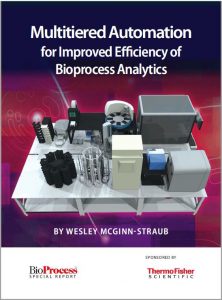 The first biopharmaceutical, human insulin, was approved for use in 1982 (1). The biopharmaceutical market continues to exhibit healthy growth now, with the number of yearly patent applications increasing by 25% annually since 1995 (2). The total pharmaceutical R&D pipeline has more than doubled since the beginning of the century (Figure 1), much of that attributable to the biologics industry segment. As this industry has matured, new platform methods have emerged, and competition has increased. Consequently, the pressures of speed, cost, labor, and space have begun to exert influence on the operations of developers. One potential solution to speeding development of a therapeutics pipeline — while controlling elements of cost, labor, and space — is to implement automation.
The first biopharmaceutical, human insulin, was approved for use in 1982 (1). The biopharmaceutical market continues to exhibit healthy growth now, with the number of yearly patent applications increasing by 25% annually since 1995 (2). The total pharmaceutical R&D pipeline has more than doubled since the beginning of the century (Figure 1), much of that attributable to the biologics industry segment. As this industry has matured, new platform methods have emerged, and competition has increased. Consequently, the pressures of speed, cost, labor, and space have begun to exert influence on the operations of developers. One potential solution to speeding development of a therapeutics pipeline — while controlling elements of cost, labor, and space — is to implement automation.
When applied correctly, automation can increase productivity by orders of magnitude while decreasing cost and errors. The historical trend is for emerging technologies to be executed and managed manually but then make a transition to automated platforms for improving efficiencies of scale during technology maturation.
When Thomas Edison created the first light bulb in 1879, manufacturing involved handblown glass at a product rate of one or two bulbs made per minute, an output that could not match the immediate demands of the technology. In 1921, glassblower William Woods and mechanical engineer David Gray developed a ribbon machine that produced 300 bulbs per minute. The next iteration of that device produced 1,600 bulbs per minute, enabling it to meet production demands for the next 100 years (3). Development and manufacturing of biologics would benefit from a similar upscale in throughput. The World Economic Forum forecasts that over half of all labor will be automated by the year 2025 (Figure 2) (4).
Just fill out the form below to download the full Special Report.
